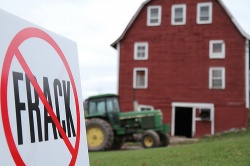Full article can be found here on Grist ….
“Fracking”: It sounds more like a comic-book exclamation (kapow! boom! frack!) than a controversial method for extracting natural gas and oil from rock deep underground. By turns demonized as a catastrophic environmental threat and glorified as a therapy for our foreign oil addiction, fracking has become a flashpoint in our national energy policy.
First developed in the 1940s, fracking — literally, “hydraulic fracturing,” or “smashing rock open with lots of water” — only began to boom around 2005, but today, it’s used in nine out of every 10 natural gas wells in the U.S. As many as 35,000 wells are fracked each year, according to the Environmental Protection Agency (EPA). And shale gas (often fracked) now accounts for 15 percent of total U.S. natural gas production, up from virtually nil a few years ago.
Scientists assure us that fracking can be done safely — at least in theory. They are still working to understand the long-term implications of using this technology at large scale in the real world, however, where things spill, accidents happen, and people have their health, homes, schools, airports, groundwater, and even cemeteries to worry about.
We know scientists aren’t the only ones looking for answers. So below, we tackle six key questions about fracking.
